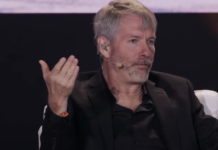
Artificial intelligence (AI) is not only revolutionizing technology but also stirring up debates in the financial sector.
Goldman Sachs has been adamant that there isn’t an AI bubble. But there are still plenty of analysts who are nervous at the major growth of interest in the AI market—and the associated spike in tech stocks. Still, the Wall Street giant offers a fresh perspective, suggesting that we are merely at the threshold of an AI revolution and far from the bubble that some anticipate.
The recent surge in AI stocks has drawn parallels with the dot-com bubble of the late 1990s, a comparison that Goldman Sachs vehemently opposes.
“Even as those stocks have rallied substantially, they don’t appear to be in a bubble” Peter Oppenheimer, chief global equity strategist at Goldman Sachs, said in a recent note. “We believe we are still in the relatively early stages of a new technology cycle that is likely to lead to further outperformance,” he concluded.
However, not everyone shares this optimistic view.
Back in July, Decrypt reported that Emad Mostaque, CEO of Stability AI (the creators of the world’s most-used open source AI image generator), cautioned about a potential “dot AI” bubble. At the time he said he believed it could surpass even the crypto market’s notorious volatility. Despite this, Mostaque acknowledges the long-term potential of AI, emphasizing its transformative power in various sectors, including banking.
Goldman Sachs projects a substantial increase in artificial intelligence investments globally, potentially reaching $200 billion by 2025. This growth is attributed to the significant economic potential of generative AI, a branch of AI specializing in creating new content based on large language models, which could bring up to $4.4 trillion to the global economy according to reports previously covered by Decrypt.
And AI stocks have performed extremely well through the year, boosting the recovery of the whole SP500 index after the slip of 2022. “The valuations of the stocks leading the market are not as stretched as in previous periods, such as the internet bubble that collapsed in 2000, and the companies have unusually strong balance sheets and returns on investment,” the report reads.
While the prospects are promising, other experts urge caution, advocating for a measured approach to investment in the AI sector. But is it too early or too late to invest?
Oppenheimer created what he called the PEARL framework to help you decide after doing your own research.
According to his methodology if you are decided to put your money into tech, a good idea is to diversify your portfolio into into five groups of companies: Pioneers (the innovators), Enablers (the ones that make it possible to commercialize the technology), Adapters (companies that change their business models to implement AI solutions), Reformers (companies that are entering the market), and Laggards (big companies that don’t need to change their model).
This seems like a lot of work, but when there’s money involved every single bit of knowledge is important. Perhaps you should save yourself the trouble and ask ChatGPT to build your AI strategy. (Please, don’t.)








